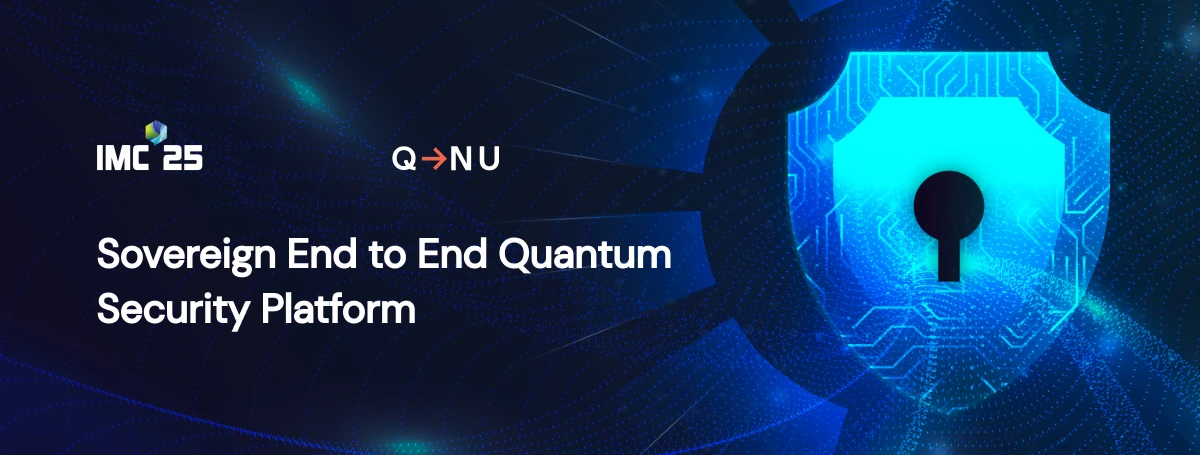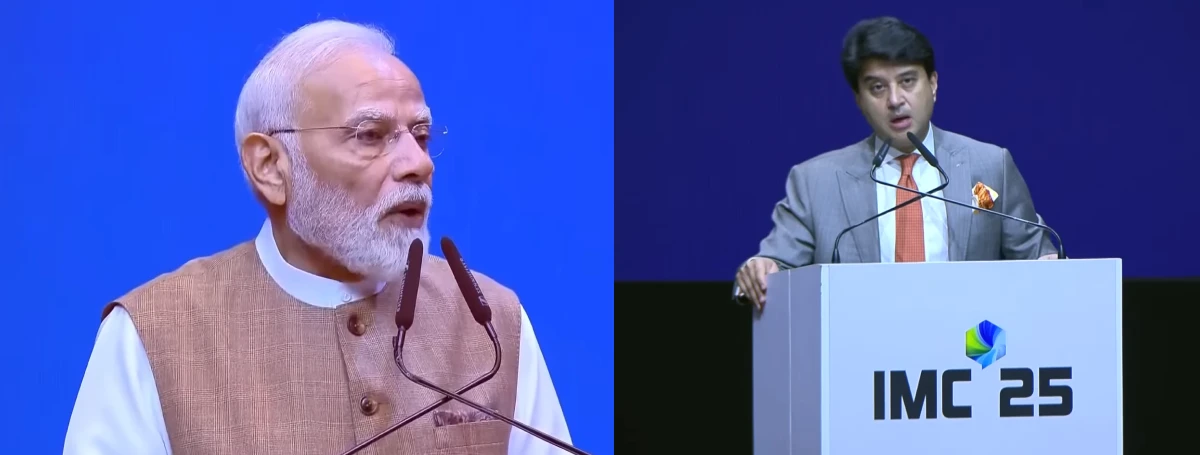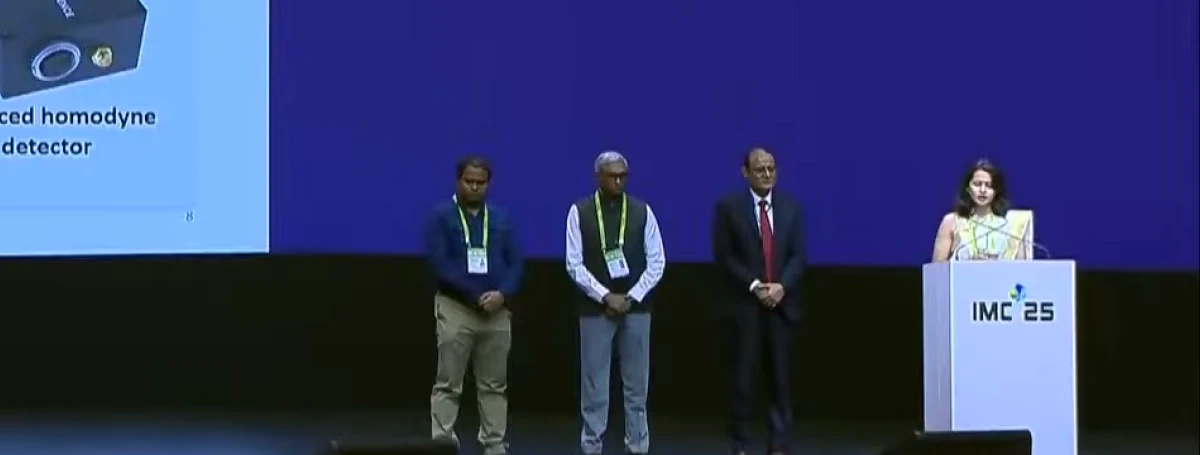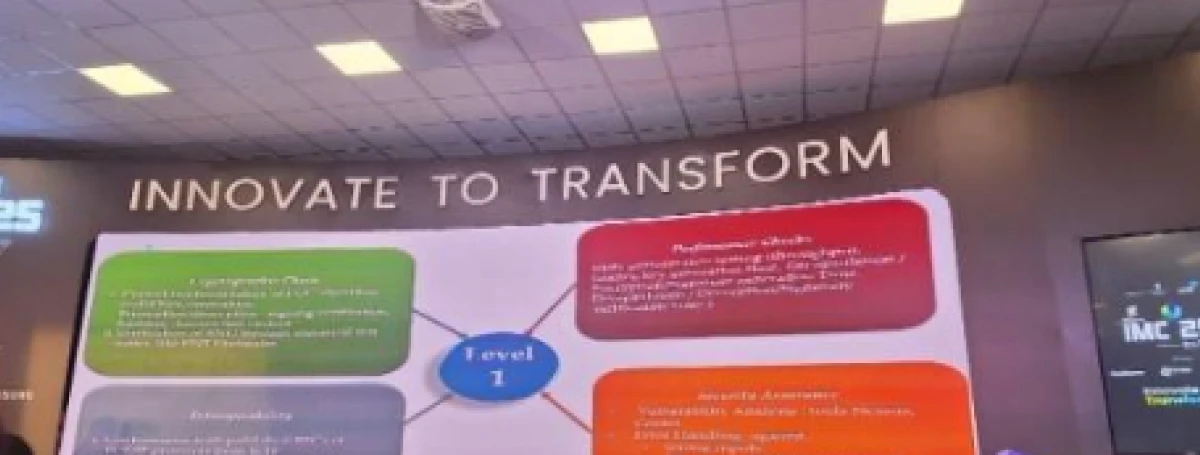Are You Ready to Witness the Future of Data Security?
Platform
©2025 QuNu Labs Private Limited, All Rights Reserved.

In a world where technology conferences often feel like corporate expos, India Mobile Congress (IMC) 2025 felt refreshingly different. It wasn’t just focused on 6G, semiconductors, or quantum breakthroughs; rather, it focused on people, partnerships, and purpose.
IMC 2025, organised jointly by the Department of Telecommunications and the Cellular Operators Association of India under the Ministry of Communications, aimed to showcase India's achievements in 5G, 6G, and emerging technologies.
Held under the theme “Innovate to Transform”, IMC 2025 became a powerful framework for India’s startups, universities, and deep-tech innovators to demonstrate that innovation must be Atmanirbhar, i.e., India needs its own technologies for every sector rather relying on other country’s innovation making herself a self-reliant, inclusive, and globally competitive economy, moving from service nation to product nation.
Many innovators, such as Ericsson, BSNL, Qualcomm, Nokia, Airtel, Jio, VVDN Technologies, Samsung, and Snapdragon, alongside medium-sized enterprises and Indian startups across several industries, showcased the spirit of Atmanirbhar Bharat (Self-Reliant India), echoing the vision of Honourable Prime Minister Narendra Modi.

Complementing the industry’s energy were key government bodies, such as (the Ministry of Telecommunication, Union Minister Shri Jyotiraditya M Scindia, the Ministry of Science and Technology, the Department of Science and Technology (DST), Government of India, and policymakers, including GSMA, supported by leading academic institutions such as IITs, reputed engineering colleges, and MBA institutes. The DST actively championed this innovation wave, supporting startups to display their groundbreaking technologies under the DST pavilion, underscoring India’s unified drive toward indigenous innovation and inclusion.
The diversity at IMC 2025 reflected growth story of India, from academic to regional innovators. Researchers from corporate, tier-1, 2, 3 universities participated and showcased their innovation, this exemplified how expertise and opportunity are reaching beyond metro corridors. By nurturing national talent, the Indian quantum ecosystem is creating jobs, research opportunities, and spin-offs. As per NITI Aayog’s Quantum Technologies Report, this sector could generate over 45,000 specialised roles by 2030.

Technology advancement doesn’t happen in isolation; it grows stronger through inclusivity. At this year’s India Mobile Congress (IMC 2025), diversity wasn’t just restricted to theme; it was a living demonstration. From quantum startups in Bengaluru, Madras to engineering students across India, the event brought together innovators building the blocks of India’s digital sovereignty. With the theme “Innovate to Transform,” IMC became a stage beyond 5G and 6G discussions but for India’s indigenous strength in quantum technologies and cybersecurity.
At IMC, on day 2, a session on Quantum-safe communication was hosted by DST, where featured conversations were led by Abhay Karandikar, Secretary to the Government of India, in the Department of Science & Technology (DST), professors from IIT Delhi and Madras, scientists, corporate leaders from SEBI.

A panel discussion was set up including various quantum tech leaders across industries alongside QNu Labs’ CEO Sunil Gupta. He explained quantum-safe offerings across defence, enterprises, telecom, BFSI, pharma, and healthcare sectors.
These sessions demystified quantum-safe communication and highlighted how academia, government, and enterprise collaboration can make quantum security mainstream.
Such dialogues help foster clarity for CXOs, business leaders, quantum evangelists, students, and policymakers. Quantum technology is no longer future talk—it’s business readiness in motion
One of IMC’s defining features this year was the inclusivity of its Startup Zone, more than 150 emerging companies showcased solutions across under “Aspire” platform from various industries including telecom, defence, fintech, agriculture, smart cities, IT, drone, satellite, manufacturing, and healthcare. The Department of Science and Technology (DST) played an instrumental role in mentoring early-stage deep-tech ventures, underscoring the government’s intent to support grassroots innovation.
These startups weren’t mere exhibitors. They were active participants in shaping India’s strategic autonomy in cybersecurity, semiconductors, and quantum communication, key enablers for self-reliance and global competitiveness.
India's quantum technology market will reach $1.2 billion by 2030. The sector could create 45,000 specialised positions.
The global quantum cryptography market jumped from $984.6 million in 2025 to a projected $7,922 million by 2032 which is a 48.7% compound annual growth rate.
Over four days at IMC 2025's exhibition halls, a pattern emerged in conversations with governments, policy makers (GSMA), honorary dignitaries who flew across the globe, C level executives, research scientists, and professors. Three main quantum security questions dominated conversations with CXOs for which QNu answered as follows:
A Gartner 2024 survey found that 62% of CISOs view quantum threat as a top emerging risk, yet only 23% have begun mitigation. The clock is ticking.
During the live demonstration at IMC 2025, QNu Labs presented real-time quantum encryption in action — transmitting data over an optical fibre quantum link on Sterlite Technologies’ (STL) infrastructure and integrating quantum-safe communication protocols with BSNL’s national network. Visitors, including senior officials from the Department of Telecommunications and the Prime Minister’s Office, witnessed end-to-end quantum key distribution (QKD) backed by DST. The showcase underscored the readiness of India’s telecom backbone for secure quantum communication, aligning with the National Quantum Mission.
Check out more details from the official announcements:
IMC 2025 Marks a Breakthrough Moment for QNu Labs in Advancing Quantum Security Leadership
With leaders like QNu Labs, India has moved beyond research to real-world deployments. From defence communication networks to BFSI and telecom use cases. Each collaboration showcased at IMC 2025 wasn’t just symbolic; it was proof of deployment, proof of capability, and proof of India’s readiness towards self-reliant nation.
QNu Labs, 100% Indian-made with global presence over USA, APAC, Middle East, and Europe,and world’s only hybrid full-stack quantum-cybersecurity company, presented complete portfolio to our Hon’ble PM Narendra Modi, other union and state ministries, corporates, government delegates, industry and business leaders, academia, and media.
Three major MOUs created immediate opportunities:
BSNL collaboration: Quantum-safe services across India's most widely deployed telecom network, serving armed forces, PSUs, enterprises, and banks.

STL partnership: Quantum-safe communications over optical fibre. They've already transmitted quantum key distribution systems over 170 kilometres of STL's infrastructure.

VTU Talent Development: Visvesvaraya Technological University partners with QNu to set up Quantum Communication Lab in Bengaluru, building quantum-ready talent today.

QNu Labs’ integrated end-to-end hybrid quantum-safe cybersecurity platform combining Quantum Key Distribution (QKD), Quantum Random Number Generator (QRNG), and Post Quantum Cryptography (PQC), positions India as a global leader in hybrid quantum resilience. QNu’s QShieldTM is an example of self-reliant quantum shield that has been made, and patented and is an enterprise and defence-grade SaaS based platform.
Check out our case studies, guides and whitepapers to start your journey to quantum-safe future.
QNu’s success (being invested by National Quantum Mission) gives inspiration how deep-tech startups, government, enterprises, academia, and policymakers can work together to build secure, self-reliant digital infrastructure.
The ASPIRE programme connected 500+ startups with investors and potential customers from government, defence, and critical infrastructure sectors.
The IMC conversations made one thing clear: the future of cybersecurity won’t be defined by fear of quantum threats but by confidence in quantum-safe solutions.
How is India Mobile Congress 2025 different from previous years?
IMC 2025 showcased real quantum security deployments, not prototypes. Strategic MOUs with BSNL, STL, and VTU created immediate implementation pathways. The ASPIRE programme connected 500+ startups with investors and government customers.
What are the main quantum security solutions available today?
Quantum Key Distribution (QKD) uses quantum physics principles for unbreakable encryption. Post-Quantum Cryptography (PQC) develops algorithms resistant to quantum attacks. Hybrid approaches combine both for comprehensive protection.
Which industries need quantum security most urgently?
Defence, BFSI (banking, financial services, insurance), telecom, healthcare, and critical infrastructure face the highest quantum threats due to sensitive data with long protection requirements.
What is National Quantum Mission?
The National Quantum Mission provides frameworks, funding mechanisms, and ecosystem support for quantum technology development. It's accelerating partnerships between academia, startups, and enterprises.
How much does quantum security implementation cost?
Costs vary by organisation size and requirements. Early adopters report 23% faster compliance audits and 19% advantages in government contracts, creating ROI beyond security benefits.
Can small and medium businesses afford quantum security?
Partnerships with providers like QNu Labs enable scalable implementations. Telecom operators offering quantum-safe services through existing networks make solutions accessible across business sizes.
What's crypto agility and why is it essential?
Crypto agility means systems can rapidly switch between cryptographic algorithms as threats evolve. It's essential for adapting to quantum-resistant cryptography without complete system overhauls.